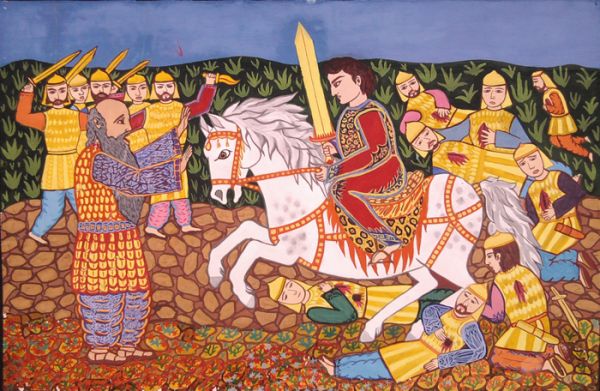
Intangible cultural heritage is the integrity of customs, traditions, rites, representations and expressions, knowledge and skills as well as the instruments, objects, artifacts and cultural spaces associated therewith as materialized carriers of intangible cultural heritage- that the public, groups and, in some cases, individuals recognize as part of their cultural heritage.
Intangible cultural values is the information – kept at scientific and educational institutions, archives, libraries, with legal and natural persons – relating to folklore, language, dialects and subdialects, place names, content of the coat of arms and other national symbols, traditional craftsmanship, national customs, traditions, holidays, rites, social practices, ways and rules of conduct, folk art, economic activities, sustenance culture, popular belief, worship, findings and methods of scientific research, objects of intangible cultural heritage.
The preservation of intangible cultural heritage is one of the main directions of the state cultural policy of the Republic of Armenia. In recent years, there has been a resurgence in this area, with trends of respect, intimacy and new interpretations of the intangible cultural heritage among the youth. This is reflected in the increasing number of NGOs performing preservation activities for a song, dance, handicraft, craftsmanship, folk theater groups and heritage, and various events.
Currently, the state policy of the Republic of Armenia is directed to the preservation, safeguarding, and dissemination of the sector, which is regulated by the laws of the Republic of Armenia and UNESCO International Conventions.
The Republic of Armenia ratified the UNESCO 2003 Convention for “The Safeguarding of Intangible Cultural Heritage” in 2006, and various local and international projects are being implemented to preserve, safeguard and disseminate intangible cultural heritage in the frame of the convention.
On 7 October 2009, the RA National Assembly adopted the Law on “Intangible Cultural Heritage”. The law regulates the legal relations arising from the processes of preservation, safeguarding, and development of intangible cultural heritage, including issues of identification, documentation, research, application, recreation, teaching, dissemination of intangible cultural values, protection of the property rights over such values, maintenance of intangible cultural heritage of the Republic of Armenia, international cultural cooperation, cultural communication between peoples of foreign countries and those of the Republic of Armenia, it defines the procedure for participation of natural and legal persons in this sector, as well as the powers of state bodies.
A professional council on the issues of intangible cultural heritage safeguarding was established under the RA Minister of Culture in 2009 which, in cooperation with scientific and educational organizations, developed and submitted for Government approval standards for the inventory of RA intangible cultural heritage.
Several legislative acts have also been adopted to promote the administration of the legal framework of the sector which enables to regulate the legal relations arising, in the processes of preservation, safeguarding, and development of intangible cultural heritage; the activities of communities that create, preserve and transmit intangible cultural values; international cultural cooperation, etc.
On March 11, 2010, the RA Government approved the Decision № 310-A “On Defining the Criteria for Preparing the Lists of Intangible Cultural Values and Approving the List of Intangible Cultural Heritage Values. The basis for the process of registration of the intangible cultural heritage in the territory of the Republic of Armenia, the study of the situation, as well as the first list of intangible cultural heritage values were established. Currently, it includes 33 values,
On January 20, 2011, the RA Government approved the Decision №6-N on “The Criteria for Preparing the Lists of Intangible Cultural Heritage in Need of Urgent Safeguarding, and the List of Intangible Cultural Heritage Values Based thereon”
On March 1, 2012, the RA Government approved the Decision №241-N on “Approving the criteria for defining cultural spaces and published the list of cultural spaces.” It includes two cultural spaces.
Cultural programs are implemented to ensure the viability and the continuity of transmission of intangible cultural heritage which is targeted at the development of folk arts, traditional craftsmanship, and the traditional performing arts, dissemination of folk heritage, protecting the viability of the traditional national lifestyle and international dissemination of culture. The website: https://int-heritage.am/ has been operating since 2016 which is aimed at the popularization of the sector.
Special emphasis is placed on the implementation of cultural programs in the regions, which promotes the preservation of national traditions, the provision of livelihoods and the transfer from generation to generation.
Various cultural events (festivals, republican and international conferences, participation in seminars, workshops, etc.) are being organized to promote the dissemination of intangible cultural heritage; and applications for national intangible cultural values to be included in the UNESCO intangible cultural heritage list are made.
Within the process of preservation of Armenian intangible cultural heritage values, the following applications are inscribed on the representative list of the UNESCO Intangible Cultural Heritage of Humanity: “Duduk and its Music” (2008), “Armenian Cross-Stones Art. Symbolism and Craftsmanship of Khachkars” (2010), “Performance of the Armenian Epic of “Daredevils of Sassoun or 'David of Sassoun” (2012), “Lavash - the Preparation, Meaning and Appearance of Traditional Bread as an Expression of Culture in Armenia” (2014), “Kochari Traditional Group Dance” (2017), “Armenian Letter Art and its Cultural Expressions” (2019).
The research and preservation issues of intangible cultural heritage of Armenia are covered by NAS RA Institutes of Archaeology and Ethnography, Arts, Literature, Language; “Hovhannes Sharambeyan Folk Art Center”, “Museum of Woodcarving”, “Charents Museum of Literature and Arts” SNCOs; the Cabinet of Folk Arts and the chair of Armenian folk music at Komitas State Conservatory of Yerevan. The Chairs of Folklore, Ethnology, and Culturology operate at Yerevan State University.
